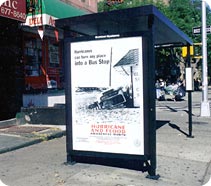|
Challenge
 Educate skeptical New York City residents -- especially those living in low-lying coastal neighborhoods -- about the potential of hurricane and flood activity in New York City and the importance of being prepared for such emergencies.
Educate skeptical New York City residents -- especially those living in low-lying coastal neighborhoods -- about the potential of hurricane and flood activity in New York City and the importance of being prepared for such emergencies.
Solution
Create an advertising/public information campaign that dramatically illustrates that New York City is prone to experiencing hurricane and flood conditions.
Result
A multiple-award winning advertising campaign that helped create awareness of the very real possibility of hurricane and flood emergencies in New York City and educated residents on how to prepare for and deal with such events when they occur.
View the Ads
View the Awards
Information About the Campaign
The Mayor's Office of Emergency Management's Hurricane and Flood Safety Awareness Campaign was designed to overcome the public's complacency towards hurricanes and floods by communicating the fact that devastating storms have struck the New York City region many times in the past, and remain a potent threat.
It was also designed to educate the public on how to prepare for such severe storms, as well as how to protect their lives, property and financial viability.
The Mayor's Office of Emergency Management conducted a series of community outreach events in areas that are particularly vulnerable to storm damage and coastal flooding. Most citizens contacted scoffed at the idea that hurricanes and floods could affect them, and said that they weren't inclined to prepare for such potential weather emergencies.
Their attitude was distressing, especially since a new federal study shows that the East Coast of the United States may be entering a long-anticipated, prolonged siege of more frequent and more destructive hurricanes and coastal storms.
It was necessary to educate New Yorkers -- particularly residents and homeowners in inundation areas -- about the history of hurricanes and floods in New York, and the importance of being prepared. The challenge was to present this information in a way that would captivate the public's attention instead of turning them off with didactic pronouncements and doomsday warnings.
A wide-ranging search of municipal archives, public library, and historical society collections uncovered 19 dramatic photographs that formed the backbone of this campaign. The photos graphically illustrated severe storm damage in New York City between 1938 and 1960, with several focusing on the "human angle" of such storms.
These photos were packaged with various headlines and tag lines, as well as copy that instructed citizens on how to obtain essential safety information. The completed advertisements were then displayed throughout New York City, and a specially-prepared, comprehensive brochure was created and made to residents through an arrangement with the New York City Public Library system.
Elements of the Campaign
A total of 103,725 safety brochures distributed to all 201 branches of the NY, Brooklyn, and Queens Borough Public Libraries. Each library also received an 11" x 17" poster.
A total of 300 24" x 18" posters displayed in the public areas of all New York City Housing Authority developments that are situated in inundation zones.
A total of 1140 22" x 21" "premium squares" displayed in subway cars.
A total of 100 47.5" X 67.5" posters displayed on bus shelters throughout the City.
A total of 400 30" x 46" one-sheet posters displayed on subway platforms throughout the City.
The Office of Emergency Management's website, which contained information on the history of storms in NYC, storm preparation tips, the Federal Emergency Management Agency's Flood Insurance Program, and links to appropriate weather and emergency management sites. Color reproductions of all 19 Hurricane Awareness ads we also posted on the site.
Campaign Accomplishments
This campaign reached the millions of people who used New York City's library and transit systems from September 1998 through January 1999. Various media outlets, including The New York Times, the Fox News Network, and the Univision Network featured stories on this campaign and helped disseminate important safety information. (The campaign was also posted during the 1999 and 2001 hurricane seasons).
The campaign also generated invitations for OEM officials to speak with community groups and public school students, and OEM's website received many thousands of "hits" from citizens seeking information. In addition, Mayor Rudolph W. Giuliani presented the campaign to the Mayor of Miami during his visit to Florida in the wake of Hurricane Bonnie.

|